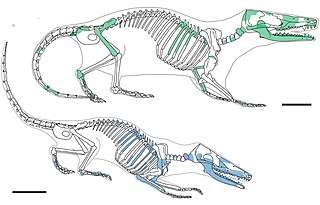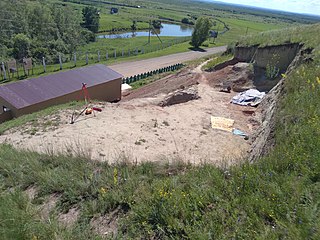
Docodonta is an order of extinct Mesozoic mammaliaforms. They were among the most common mammaliaforms of their time, persisting from the Middle Jurassic to the Early Cretaceous across the continent of Laurasia. They are distinguished from other early mammaliaforms by their relatively complex molar teeth. Docodont teeth have been described as "pseudotribosphenic": a cusp on the inner half of the upper molar grinds into a basin on the front half of the lower molar, like a mortar-and-pestle. This is a case of convergent evolution with the tribosphenic teeth of therian mammals. There is much uncertainty for how docodont teeth developed from their simpler ancestors. Their closest relatives may have been certain Triassic "symmetrodonts", namely Woutersia, Delsatia, and Tikitherium.

Dryolestida is an extinct order of mammals, known from the Jurassic and Cretaceous. They are considered basal members of the clade Cladotheria, close to the ancestry of therian mammals. It is also believed that they developed a fully mammalian jaw and also had the three middle ear bones. Most members of the group, as with most Mesozoic mammals, are only known from fragmentary tooth and jaw remains.

Dryolestidae is an extinct family of Mesozoic mammals, known from the Middle Jurassic to the Early Cretaceous of the North Hemisphere. The oldest known member, Anthracolestes, is known from the Middle Jurassic Itat Formation of Western Siberia, but most other representatives are known from the Late Jurassic of North America and the Late Jurassic and Early Cretaceous of Europe. Most members are only known from isolated teeth and jaw fragments. Like many other groups of early mammals, they are thought to have been insectivores. They are generally classified in Cladotheria, meaning that they are considered to be more closely related to marsupials and placentals than to monotremes. They are placed as part of the broader Dryolestida, which also includes the Paurodontidae, and also sometimes the South American-Antarctic Meridiolestida, which are often considered unrelated cladotherians. Dryolestidae taxon is not based on a phylogenetic definition, but instead on the possession of unequal roots for the molars of the lower jaw. Additionally, the clade is distinguished by hypsodonty in lower molars, and uneven labio-lingual height for the alveolar borders of the dentary.

Shuotheriidae is a small family of Jurassic mammals whose remains are found in China, England and possibly Russia. They have been proposed to be close relatives of Australosphenida, together forming the clade Yinotheria. However, some studies suggest shuotheres are closer to therians than to monotremes, or that australosphenidans and therians are more closely related to each other than either are to shuotheres.
Triconolestes is an extinct genus of Late Jurassic eutriconodont mammal from the Morrison Formation, present in stratigraphic zones 4. Known from only a single molar, it is a small mammal typically considered an amphilestid. However, it has also been compared to Argentoconodon, which has been considered a volaticothere related to gliding mammals such as Volaticotherium and Ichthyoconodon.

Dryolestes is an extinct genus of Late Jurassic mammal from the Morrison Formation and the Alcobaça Formation of Portugal. The type species Dryolestes priscus is present in stratigraphic zones 2, 5, and 6.

Triconodontidae is an extinct family of small, carnivorous mammals belonging to the order Eutriconodonta, endemic to what would become Asia, Europe, North America and probably also Africa and South America during the Jurassic through Cretaceous periods at least from 190–70.6 mya.
The Balabansai Formation is a geological formation in Kazakhstan, Kyrgyzstan and Uzbekistan whose strata date back to the Bathonian and Callovian stages of the Middle Jurassic. Dinosaur remains are among the fossils that have been recovered from the formation. The lithology primarily consists of variegated sandstones, siltstones, claystones, and rare gravels and marls. Many taxa have been found in the formation, including amphibians and mammals
The Itat Formation is a geologic formation in western Siberia. It was deposited in the Bajocian to Bathonian ages of the Middle Jurassic. Dinosaur remains are among the fossils that have been recovered from the formation, including the proceratosaurid Kileskus, as well as fish, amphibians, mammals and many other vertebrates. The formation is noted for bearing significant coal reserves, with large open pit coal mines extracting lignite from the unit currently in operation.
Paritatodon is an extinct mammal which existed in Kyrgyzstan and England during the Jurassic period. It was originally the holotype specimen of Shuotherium kermacki, but Martin and Averianov (2010) argued that it resembled the genus Itatodon (Docodonta) and so renamed it Paritatodon.
The Amphidontidae are a family of extinct mammals from the Early Cretaceous, belonging to the triconodonts. It contains most of the species previously belonged to Amphilestidae.
Sineleutherus is an extinct genus of euharamiyids which existed in Asia during the Jurassic period. The type species is Sineleutherus uyguricus, which was described by Thomas Martin, Alexander O. Averianov and Hans-Ulrich Pfretzschner in 2010; it lived in what is now China during the late Jurassic Qigu Formation. A second species, Sineleutherus issedonicus, was described by A. O. Averianov, A. V. Lopatin and S. A. Krasnolutskii in 2011. It lived in what is now Sharypovsky District during the middle Jurassic ; its fossils were collected from the upper part of the Itat Formation. However, this is now believed to represent several euharamiyid taxa not closey related to Sineleutherus.
Nanolestes is an extinct genus of mammals in the order Amphitheriida from the Late Jurassic of Eurasia. Two species, N. krusati and N. drescherae are known from the Alcobaça Formation in Portugal. Another species, N. mackennai, was described from the Oxfordian aged Qigu Formation of China by Thomas Martin, Alexander O. Averianov and Hans-Ulrich Pfretzschner in 2010.

The Ilek Formation is a Lower Cretaceous geologic formation in Western Siberia. Many different fossils have been recovered from the formation. It overlies the Late Jurassic Tyazhin Formation and underlies the Albian Kiya Formation.
Argentoconodon is an extinct genus of theriimorph mammal from the Cañadón Asfalto Formation of the Cañadón Asfalto Basin in Patagonia. When originally described, it was known only from a single molariform tooth, which possessed a combination of primitive and derived features. The tooth is currently held in the Museo Paleontológico Egidio Feruglio, where it was given the specimen number MPEF-PV 1877. New material described in 2011 show that Argentoconodon was similar to Ichthyoconodon, Jugulator and Volaticotherium within the family Triconodontidae, and possibly also Triconolestes.

Meridiolestida is an extinct clade of mammals known from the Cretaceous and Cenozoic of South America and possibly Antarctica. They represented the dominant group of mammals in South America during the Late Cretaceous. Meridiolestidans were morphologically diverse, containing both small insectivores such as the "sabretooth-squirrel" Cronopio, as well as the clade Mesungulatoidea/Mesungulatomorpha, which ranged in size from the shrew-sized Reigitherium to the dog-sized Peligrotherium. Mesungulatoideans had highly modified dentition with bunodont teeth, and were likely herbivores/omnivores. Meridiolestidans are generally classified within Cladotheria, more closely related to living marsupials and placental mammals (Theria) than to monotremes, barring one study recovering them as the sister taxa to spalacotheriid "symmetrodonts". However, more recent studies have stuck to the cladotherian interpretation. Within Cladotheria, they have often been placed in a group called Dryolestoidea together with Dryolestida, a group of mammals primarily known from the Jurassic and Early Cretaceous of the Northern Hemisphere. However, some analyses have found this group to be paraphyletic, with the meridiolestidans being more or less closely related to therian mammals than other dryolestidans are. Meridiolestidans differed from northern dryolestoids in the absence of a parastylar hook on the molariform teeth and the lack of a Meckelian groove.

Maiopatagium is an extinct genus of gliding euharamiyids which existed in Asia during the Jurassic period. It possessed a patagium between its limbs and presumably had similar lifestyle to living flying squirrels and colugos. The type species is Maiopatagium furculiferum, which was described from the Tiaojishan Formation by Zhe-Xi Luo in 2017; it lived in what is now the Liaoning region of China during the late Jurassic .Maiopatagium and Vilevolodon, described concurrently, offer clues to the ways various synapsids have taken to the skies over evolutionary time scales. A second species, M. sibiricum, was described from the Bathonian aged Itat Formation in western Siberia, Russia in 2019
Simpsonodon is an extinct genus of docodontan mammaliaform known from the Middle Jurassic of England, Kyrgyzstan and Russia. The type species S. oxfordensis was described from the Kirtlington Mammal Bed and Watton Cliff in the Forest Marble Formation of England. It was named after George Gaylord Simpson, a pioneering mammalologist and contributor to the Modern Evolutionary Synthesis. A second species S. sibiricus is known from the Itat Formation of Russia, and indeterminate species of the genus are also known from the Balabansai Formation in Kyrgyzstan
Itatodon is an extinct genus of primitive mammal known from the Bathonian aged Itat Formation of Russia. The genus is named after the formation, with the species being named after Leonid Petrovich Tatarinov who described the first docodont from Asia. It is known from a holotype right lower molar and referred isolated right lower molar and fragment of the left lower molar. When it was first described, it was thought to be a docodontan, but one recent phylogenetic studies have assigned it, along with its close relative Paritatodon to Shuotheriidae, while others continue to consider it a docodont.

The Süntel Formation, previously known as the Kimmeridge Formation, is a geological formation in Germany. It is Late Jurassic in age, spanning the early to late Kimmeridgian stage. It predominantly consists of limestone deposited in shallow marine carbonate ramp conditions.











